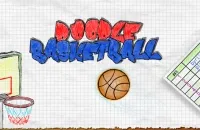Doodle Baseball
Doodle Baseball
Connecting to game server...
0% complete

Doodle Baseball
Click to start playing
🕹️ You May Also Like












Doodle Baseball
Google's charming hand-drawn baseball game with intuitive timing-based batting mechanics. Step up to the plate and hit home runs in this delightful arcade game.
Doodle Baseball is Google's delightful take on America's pastime, featuring charming hand-drawn graphics and intuitive gameplay. Step up to the plate and time your swings to hit home runs and score points. The game captures the essence of baseball with simple mechanics that are easy to learn but challenging to master. Perfect for quick gaming sessions with its pick-up-and-play design.
🎮 How to Play
- 1Click to swing the bat
- 2Time your swing for best hits
- 3Aim for different field areas
💡 Game Tips
- 💡Watch the ball's trajectory carefully
- 💡Time your swing for maximum power
- 💡Aim for gaps in the field
- 💡Practice timing with different pitch speeds
📚Complete Strategy Guide
Master Doodle Baseball with our comprehensive guide and pro tips
Basic Strategy
Doodle Baseball is Google's delightful interpretation of America's pastime, featuring charming hand-drawn graphics and intuitive timing-based mechanics. The game captures the essence of baseball through simple controls that are easy to learn but challenging to master. Success depends on developing precise timing, understanding swing mechanics, and maintaining focus throughout extended play sessions.
Timing Fundamentals: The core of Doodle Baseball success lies in developing perfect timing for different pitch types and speeds. Each pitch requires a specific timing window for optimal contact. Early swings result in foul balls or weak contact, while late swings lead to strikes or poor hits. The key is developing muscle memory for the various timing requirements.
Visual Cue Recognition: Learn to identify visual indicators that help predict pitch timing and location. The pitcher's animation, ball trajectory, and release point all provide information that can improve your timing decisions. Developing keen observation skills translates directly to improved batting performance.
Swing Decision Making: Not every pitch deserves a swing attempt. Learn to identify good pitches to hit versus those that should be taken. Patience at the plate often leads to better pitch selection and higher success rates when you do decide to swing.
Score Accumulation Strategy: Focus on consistent contact rather than always trying for home runs. Singles and doubles accumulate score more reliably than swing-for-the-fences approaches that result in frequent strikeouts. Build innings through steady hitting rather than boom-or-bust swinging.
Advanced Tips
Pitch Recognition Mastery: Different pitches have unique visual and timing characteristics. Fastballs require quick reactions, while slower pitches need patient timing. Learn to identify pitch types early in their trajectory to improve your timing preparation and decision-making.
Sweet Spot Targeting: Develop the ability to consistently make contact in the bat's sweet spot, which produces the best results. This requires precise timing that comes only through extensive practice and development of muscle memory.
Rhythm Development: Establish a consistent pre-swing routine that helps you maintain timing consistency across different pitch types and game situations. This mental preparation can significantly improve your success rate.
Pressure Situation Management: Maintain composure during high-pressure situations when the game is on the line. Anxiety and tension often disrupt timing, so developing mental techniques for staying calm and focused is crucial for clutch performance.
Streak Psychology: Understand the psychology of hitting streaks and slumps. Confidence affects timing and decision-making, so learn to maintain positive mental state regardless of recent results.
Level Walkthrough
Early Innings Approach: Use early innings to establish timing and rhythm with the pitcher. Pay attention to pitch patterns and timing cues that will help you succeed in later, more pressure-filled situations.
Mid-Game Adaptation: As you progress, pitches may become more challenging or follow different patterns. Stay alert to changes in timing requirements and adjust your approach accordingly. Successful players demonstrate flexibility in their timing and strategy.
Late-Game Pressure Management: Final innings often present the most challenging situations with increased pressure to perform. Maintain your established rhythm and timing while managing the psychological pressure of crucial at-bats.
Advanced Batting Techniques
Power vs. Contact Balance: Learn when to swing for power and when to focus on making solid contact. Power swings offer higher scores but lower success rates, while contact swings provide more consistent results. Strategic players adjust their approach based on game situation.
Timing Variation Mastery: Master the subtle timing differences required for optimal contact on various pitch types. Fastballs demand quicker reactions, curveballs require patience, and changeups test your ability to adjust timing mid-swing.
Visual Processing Enhancement: Develop the ability to quickly process visual information from pitch release to contact decision. This includes tracking ball movement, recognizing spin patterns, and predicting trajectory based on early visual cues.
Muscle Memory Development: Through repetitive practice, develop automatic timing responses that don't require conscious thought. This muscle memory allows you to perform consistently even under pressure when conscious thought might be disrupted.
Mental Game and Focus
Concentration Techniques: Maintain focus throughout extended play sessions by developing concentration techniques. This might include breathing exercises, visual focus points, or mental routines that help maintain attention on relevant game elements.
Failure Recovery: Baseball inherently involves frequent failure, so developing resilience is crucial. Learn to quickly recover from poor at-bats without letting frustration affect subsequent performance. Mental toughness often separates good players from great ones.
Confidence Maintenance: Build and maintain confidence through positive self-talk and focus on successful outcomes rather than dwelling on failures. Confidence directly impacts timing and decision-making quality.
Streak Management: Understand how to handle both hitting streaks and slumps. Success can lead to overconfidence and timing disruption, while slumps can create anxiety that further impairs performance. Maintain steady emotional state regardless of recent results.
Physics and Mechanics Understanding
Ball Trajectory Analysis: Develop understanding of how different contact points and timing affect ball trajectory. Center contact produces line drives, early contact creates pull hits, and late contact results in opposite-field hits.
Bat Speed Optimization: Learn to generate optimal bat speed for different situations. Maximum bat speed isn't always necessary—sometimes controlled swings produce better results than full-power attempts.
Contact Point Recognition: Understand the optimal contact point for different pitch locations. Inside pitches require earlier contact, outside pitches need later contact, and strike zone location affects optimal timing significantly.
Practice and Improvement Methodology
Systematic Skill Development: Focus on specific aspects of batting in isolation—timing, pitch recognition, swing decision-making—before integrating them into complete at-bat sequences. This systematic approach accelerates improvement.
Pattern Recognition Training: Practice identifying common pitch sequences and timing patterns. This pattern recognition ability allows you to anticipate and prepare for specific pitch types in game situations.
Pressure Situation Simulation: Create artificial pressure during practice by setting specific goals or imagining high-stakes situations. This mental training translates to better performance when real pressure situations arise.
Error Analysis Protocol: Systematically analyze your failures to identify patterns and root causes. Are timing errors due to anxiety, visual processing issues, or mechanical problems? Different causes require different solutions.
Game Strategy and Situational Play
Score Management: Understand when to prioritize steady scoring versus taking risks for big innings. Game situation, current score, and remaining opportunities should influence your strategic approach to each at-bat.
Risk Assessment: Learn to evaluate the risk-reward ratio of different swing decisions. Sometimes taking a strike is the better strategic choice, even when you could make contact with a difficult pitch.
Momentum Recognition: Recognize and capitalize on momentum shifts during games. Hot streaks provide opportunities for aggressive play, while cold streaks might require more conservative approaches until timing returns.
Adaptation Strategy: Develop ability to adjust your approach based on observed patterns in pitch selection, timing requirements, and game flow. Flexible players perform better across varied game conditions.
Technology and Equipment Optimization
Hardware Considerations: Ensure your playing setup provides consistent, responsive input. Whether using mouse, keyboard, or touch controls, consistent hardware behavior is crucial for developing reliable timing.
Visual Environment: Optimize your display settings and playing environment for clear visibility of game elements. Good lighting, appropriate screen brightness, and minimal visual distractions improve performance.
Audio Cues: Pay attention to any audio cues that might provide timing information or enhance the gaming experience. Sound can provide additional feedback for timing development.
Conclusion: Mastering Digital Baseball
Doodle Baseball successfully captures the essential challenge of real baseball—the demanding requirement of precise timing under pressure. Success comes from developing both technical skills and mental approaches that mirror those needed in actual baseball.
The game rewards patience, practice, and systematic skill development. Like real baseball, improvement comes through understanding failure, learning from mistakes, and gradually building the muscle memory and mental approaches necessary for consistent success.
Whether you're looking for casual entertainment or serious skill development, Doodle Baseball provides an engaging platform for experiencing the timeless challenge of hitting a moving target with precise timing. Step up to the plate—the pitcher is ready.
Mid-Game Adjustments: As the game progresses, pitches may vary in speed or location. Adapt your timing and approach based on what you're seeing. Successful players make continuous micro-adjustments throughout the game.
Late-Game Execution: Pressure increases in late innings, potentially affecting your timing and decision-making. Maintain your established approach and trust your developed skills rather than trying to do too much.
Momentum Building: Successful hits create momentum that can carry over to subsequent at-bats. Use positive results to build confidence while learning from unsuccessful attempts without letting them affect future performance.
Endgame Scenarios: Different score situations require different approaches. When leading, focus on consistent contact and avoiding strikeouts. When trailing, you may need to take more calculated risks for extra-base hits.
Common Mistakes
Overswinging for Power: Attempting to hit home runs on every swing leads to poor timing and frequent strikeouts. Focus on making solid contact rather than trying to maximize distance on every pitch.
Poor Pitch Selection: Swinging at pitches outside the strike zone or in difficult locations reduces success probability. Develop patience and discipline to wait for pitches you can handle effectively.
Timing Inconsistency: Varying your swing timing based on emotion or pressure rather than maintaining consistent mechanics leads to unpredictable results. Stick to your developed timing approach regardless of the situation.
Overthinking Mechanics: Becoming too analytical about swing mechanics during gameplay can disrupt natural timing. Trust your practiced instincts rather than consciously controlling every aspect of your swing.
Pressure Overreaction: Changing your entire approach during pressure situations often leads to worse results than maintaining your established methods. Trust your developed skills when the game is on the line.
Score Optimization
High Score Pursuit: Achieving maximum scores requires consistent success over extended periods. Focus on maintaining concentration and timing consistency throughout long sessions rather than peaking briefly.
Perfect Game Achievement: Completing games without strikes or weak contact demonstrates mastery of all timing and recognition skills. This requires sustained excellence and deep understanding of pitch recognition.
Streak Building: Developing long hitting streaks showcases consistent timing and decision-making abilities. Focus on making solid contact on good pitches while avoiding poor swing decisions.
Clutch Performance: Succeeding in pressure situations demonstrates true mastery of mental game management combined with technical skills. Practice maintaining performance when it matters most.
Consistency Demonstration: Showing reliable performance across multiple games and sessions proves that your skills are genuine rather than lucky hot streaks.
Final Pro Tips
Practice Session Structure: Organize practice sessions to work on specific aspects of hitting rather than just playing full games. Focus on timing different pitch types or working on specific situations.
Mental Preparation: Develop pre-game mental routines that put you in the optimal mindset for success. This might include visualization, breathing exercises, or focus techniques.
Fatigue Management: Extended play sessions can lead to decreased concentration and timing accuracy. Take breaks when you notice performance degradation rather than pushing through fatigue.
Environmental Optimization: Ensure your playing environment supports good timing and concentration. This includes proper lighting, comfortable seating, and minimal distractions.
Equipment Considerations: If using different devices or input methods, spend time adjusting to any timing differences that might exist between platforms or control schemes.
Recording and Analysis: Consider recording successful sessions to analyze what techniques and approaches work best for you. Visual review can reveal patterns and techniques that improve future performance.
Community Learning: Engage with other Doodle Baseball players to share strategies and learn new approaches. Different players often discover unique techniques that can improve your own game.
Enjoyment Maintenance: Remember that Doodle Baseball is designed to be fun and accessible. While improvement is satisfying, don't lose sight of the game's charming presentation and inherent enjoyment.
Doodle Baseball successfully combines simple, intuitive gameplay with depth that rewards skill development, offering players a delightful baseball experience that captures both the strategic elements of the sport and the satisfaction of well-timed athletic performance through charming visual design and engaging mechanics.